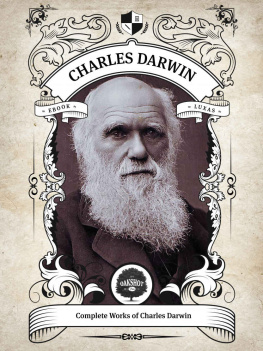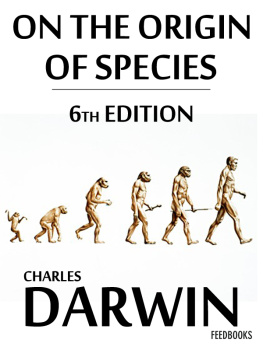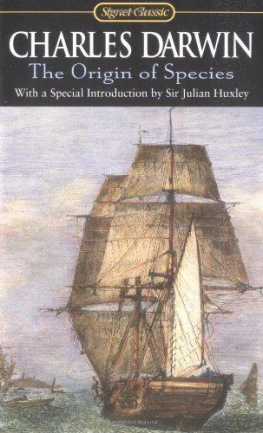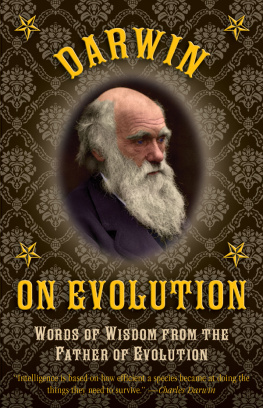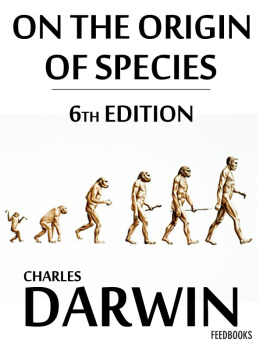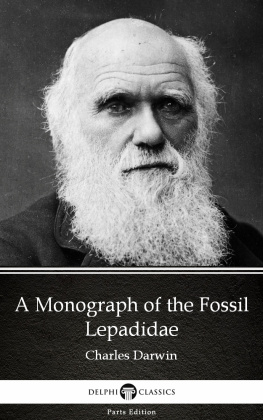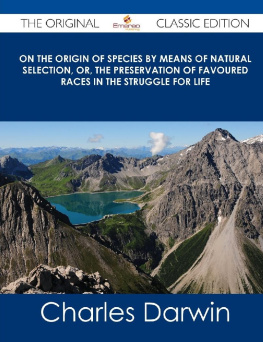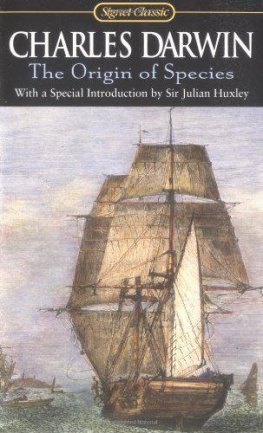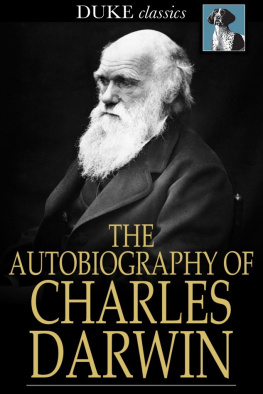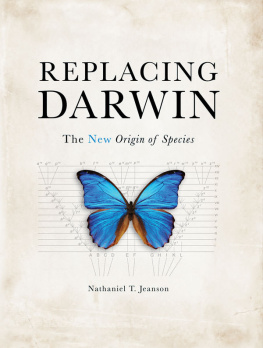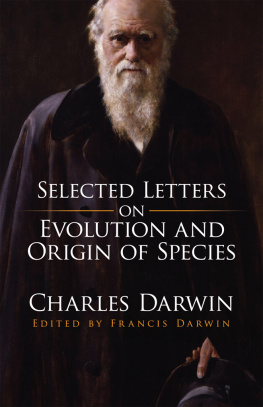Charles Darwin - Oakshot Complete Works of Charles Darwin
Here you can read online Charles Darwin - Oakshot Complete Works of Charles Darwin full text of the book (entire story) in english for free. Download pdf and epub, get meaning, cover and reviews about this ebook. year: 2016, publisher: Oakshot Press, genre: Romance novel. Description of the work, (preface) as well as reviews are available. Best literature library LitArk.com created for fans of good reading and offers a wide selection of genres:
Romance novel
Science fiction
Adventure
Detective
Science
History
Home and family
Prose
Art
Politics
Computer
Non-fiction
Religion
Business
Children
Humor
Choose a favorite category and find really read worthwhile books. Enjoy immersion in the world of imagination, feel the emotions of the characters or learn something new for yourself, make an fascinating discovery.
- Book:Oakshot Complete Works of Charles Darwin
- Author:
- Publisher:Oakshot Press
- Genre:
- Year:2016
- Rating:3 / 5
- Favourites:Add to favourites
- Your mark:
Oakshot Complete Works of Charles Darwin: summary, description and annotation
We offer to read an annotation, description, summary or preface (depends on what the author of the book "Oakshot Complete Works of Charles Darwin" wrote himself). If you haven't found the necessary information about the book — write in the comments, we will try to find it.
Charles Robert Darwin, (/drwn/; 12 February 1809 19 April 1882) was an English naturalist and geologist, best known for his contributions to evolutionary theory. He established that all species of life have descended over time from common ancestors, and in a joint publication with Alfred Russel Wallace introduced his scientific theory that this branching pattern of evolution resulted from a process that he called natural selection, in which the struggle for existence has a similar effect to the artificial selection involved in selective breeding.
Darwin published his theory of evolution with compelling evidence in his 1859 book On the Origin of Species, overcoming scientific rejection of earlier concepts of transmutation of species. By the 1870s, the scientific community and much of the general public had accepted evolution as a fact. However, many favoured competing explanations and it was not until the emergence of the modern evolutionary synthesis from the 1930s to the 1950s that a broad consensus developed in which natural selection was the basic mechanism of evolution. In modified form, Darwins scientific discovery is the unifying theory of the life sciences, explaining the diversity of life.
Darwins early interest in nature led him to neglect his medical education at the University of Edinburgh; instead, he helped to investigate marine invertebrates. Studies at the University of Cambridge (Christs College) encouraged his passion for natural science. His five-year voyage on HMS Beagle established him as an eminent geologist whose observations and theories supported Charles Lyells uniformitarian ideas, and publication of his journal of the voyage made him famous as a popular author.
Puzzled by the geographical distribution of wildlife and fossils he collected on the voyage, Darwin began detailed investigations and in 1838 conceived his theory of natural selection. Although he discussed his ideas with several naturalists, he needed time for extensive research and his geological work had priority. He was writing up his theory in 1858 when Alfred Russel Wallace sent him an essay that described the same idea, prompting immediate joint publication of both of their theories. Darwins work established evolutionary descent with modification as the dominant scientific explanation of diversification in nature. In 1871 he examined human evolution and sexual selection in The Descent of Man, and Selection in Relation to Sex, followed by The Expression of the Emotions in Man and Animals. His research on plants was published in a series of books, and in his final book, he examined earthworms and their effect on soil.
Darwin has been described as one of the most influential figures in human history; he was honoured by burial in Westminster Abbey.
Bio from Wikipedia, the free encyclopedia.
Update 2 - 1st November 2016
Reviewed and updated all books to include either paragraph indents or correct line spacing between paragraphs to make it easier for the user to read and distinguish paragraph start and end.
Ebook specifically formatted for kindle devices and tested with all Kindle 5 way navigation functions and Kindle table of contents button. Ebook comes with main table of contents and interlinked sub table of contents. Ebook contains illustrations and inline footnotes where applicable.
Each chapter is clearly marked so user knows which book within the boxset is being read.
The Books.
- The Structure And Distribution Of Coral Reefs. (Illustrated / Inline Footnotes)
- Geological Observations On Volcanic Islands. (Illustrated / Inline Footnotes)
- Geological Observations on South America. (Illustrated / Inline Footnotes)
- Journal of Researches Vol 1&2 (Illustrated / Inline Footnotes)
- A Monograph of The Sub-Class Cirripedia. (Illustrated / Inline Footnotes)
- A Monograph Of The Fossil Lepadidae. (Illustrated / Inline Footnotes)
- A Monograph On The Fossil Balanid And Verrucid. (Illustrated / Inline Footnotes)
- On The Tendency Of Species To Form Varieties; And On The Perpetuation Of Varieties And Species By Natural Means Of Selection. (Inline Footnotes)
- On the Origin of Species by Means of Natural Selection. 1st Edition (Illustrated)
- On the Origin of Species by Means of Natural Selection. 3rd Edition (Illustrated)
- On The Various Contrivances By Which British And Foreign Orchids Are Fertilised By Insects. (Illustrated / Inline Footnotes)
- The Variation of Animals and Plants under Domestication Vol 1&2. (Illustrated / Inline Footnotes)
- On the Origin of Species by Means of Natural Selection. 6th Edition (Illustrated)
- The Expression of the Emotions in Man and Animals. (Illustrated / Inline Footnotes)
- The Descent of Man, and Selection in Relation to Sex. (Illustrated / Inline Footnotes)
- Insectivorous Plants. (Illustrated / Inline Footnotes)
- The Effects of Cross & Self-Fertilisation in the Vegetable Kingdom. (Illustrated / Inline Footnotes)
- The Different Forms Of Flowers On Plants Of The Same Species. (Illustrated / Inline Footnotes)
- The Power of Movement in Plants. (Illustrated / Inline Footnotes)
- The Formation of Vegetable Mould Through the Action of Worms / With Observations on Their Habits. (Illustrated / Inline Footnotes)
- The Movements and Habits of Climbing Plants. (Illustrated / Inline Footnotes)
- The Voyage of the Beagle. Journal Of Researches Into The Natural History & Geology Of The Countries Visited During The Voyage Round The World Of H.M.S. Beagle (Illustrated / Inline Footnotes)
The Letters.
- Life and Letters of Charles Darwin. Vol1&2 Including An Autobiographical Chapter Edited By His Son Francis Darwin.
- More Letters of Charles Darwin Vol1&2 Edited By Francis Darwin And A.C. Seward.
The Biographies.
- The Autobiography of Charles Darwin Edited by his Son Francis Darwin.
- Life of Charles Darwin by G.T Bettany. (Inline Footnotes)
- Charles Darwin by Grant Allen. (Inline Footnotes)
- Charles Darwin: His Life Told in an Autobiographical Chapter Edited By His Son, Francis Darwin. (Illustrated / Inline Footnotes)
- Famous Men of Science by Sarah. K. Knowles.
The Criticism, Essays and Reviews.
- Essays on Darwinism by Thomas R.R Stebbing. (Inline Footnotes)
- What is Darwinism? by Charles Hodge. (Inline Footnotes)
- Essays and Reviews Pertaining to Darwinism by Asa Gray. (Inline Footnotes)
- The Theories of Darwin and Their Relation to Philosophy, Religion, and Morality by Rudolf Schmid. (Inline Footnotes)
- Darwiniana Collected Essays by Thomas Henry Huxley. (Inline Footnotes)
- Darwin and Modern Science by A.C Seward and Others. - Essays In Commemoration Of The Centenary Of The Birth Of Charles Darwin And Of The Fiftieth Anniversary Of The Publication Of The Origin Of Species
Charles Darwin: author's other books
Who wrote Oakshot Complete Works of Charles Darwin? Find out the surname, the name of the author of the book and a list of all author's works by series.

